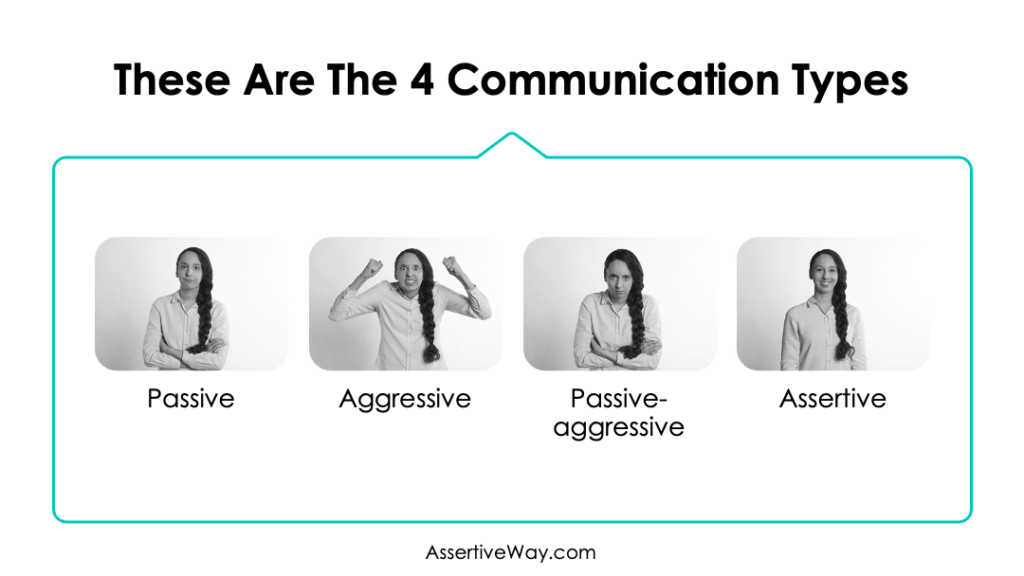By Assertive Way
Express your needs, desires, feelings, and ideas with “I statements” in a respectful way. Avoid weak and insecure language. Manage your negative emotions. And be curious about other people’s behaviors and feelings.
In This Article You’ll:
- Understand what assertiveness means and how it can help you
- Identify the 4 communication types
- Know when to communicate assertively
- Adopt these 5 assertiveness beliefs
- Identify assertive expressions
- Recognize 20 assertiveness strategies
- Adopt an assertive body language
Sign up for our Weekly Newsletter “Nice With Limits” for tips and inspiration on how to be more assertive at work.
We take your email seriously and will never sell or share it.
How To Be Assertive At Work Without Being Rude
Do You Need To Be More Assertive At Work?
To find out if you are not assertive enough at work, answer the below questions.
If you answer yes to a few of the questions below, then you need to be more assertive at work.
Do you struggle with any of these communication challenges at work?
- Feel underappreciated, under-valued and not recognized for your hard-work?
- Often find yourself quiet in situations where you wish you had said something?
- Ruminate and replay responses over and over in your mind?
- Feel conflicted between speaking up and being a decent nice person?
- Are afraid of sounding mean, aggressive, or rude when you stand up for yourself?
- Find it hard to ask for what you want?
- Want to feel in control over your career and time?
- Miss out on opportunities at work because others don’t notice you?
Do you feel these emotional challenges at work?
- Guilt
- Impostor syndrome
- Overwhelm
- Shame
- Stress
- Hopeless
Non-Assertiveness may the reason for your frustrations!
Don’t worry, you’ll learn the basics on how to be more assertive at work without being rude in this straightforward article. If you prefer to watch the video training version of this content, check this mini training by clicking here.
Assertiveness Benefits
Being more assertive has several unexpected benefits. Here are some of the many assertiveness benefits.
- Reduce your stress and stress on others
- Be more appreciated, valued, and respected by others
- Feel more confident
- Be recognized and get more promotions
- Find your passion
- Boost your and your team’s productivity
- Be at your personal best
- Be more authentic
- Feel positive, happy, and fulfilled
- Have greater impact through your work
- Be a better leader
- Easily give and receive feedback, praise, and criticism
- Negotiate better
- Ask for what you want
- Make better decisions
- Gain more influence and power
- Feel more fulfilled
- Have more meaningful relationships
Now that you know the benefits, let’s clarify what assertiveness means.
What Does Assertiveness Mean And Is It A Skill?
Assertiveness is the ability to express and defend your needs, feelings, rights, desires, requests in a calm, thoughtful, and respectful way.
Assertiveness is NOT being:
- Extroverted
- Rude or Mean
- Aggressive
- Pushy
- Selfish
- Inconsiderate
Moreover, you can easily learn how to be more assertive because it is a skill.
All you need to do is to learn the assertiveness mindset, strategies, and to practice like any other skill. In this article you’ll get an introduction to that skill so that you can already start to implement it in your work and life and get the benefits we talked about earlier.
When To Be Assertive?
You don’t have to be assertive all the time. Assertive communication is useful to deliberately use when you have an important conversation or even an emotional conversation.
Here are some examples of when to use assertiveness in your work and life.
- When you feel guilty or shameful about an interaction
- When you feel resentful, overwhelmed, stressed or confused
- Networking & speaking in public
- When you have people-please tendencies
- When speaking up for others, for yourself, or for something you believe in
- When you want to ask for something
- When you want to say ”No”
- When you negotiate
- When you express opinions or feelings
- When you give and receive feedback
- When others take advantage of you
Now that you know what assertiveness means, its many benefits, how you can learn it, and when to use it, let’s talk about how to be more assertive at work without being rude.
The 1st step to be assertive is to recognize your most used communication style in different situations.
The 4 Communication Types
These are the four main communication types:
- Passive
- Aggressive
- Passive-aggressive
- Assertive
Here are the main characteristics of each communication type.
Passive Communication
- Don’t express themselves
- Crave acceptance
- Guilty, resentful, stressed
- Feel like a victim
- Fear rejection
- Have low confidence
- Don’t express opinions
- Find it hard to make decisions on their own
- Over justify actions
- Say ”sorry” a lot
- Avoid criticism & feedback
- Deny compliments
- Are people-pleasers
- Don’t ask for help
- Don’t make requests
Aggressive Communication
- Express themselves but disrespect others in the process
- Use control & command
- Are demanding
- Act hostile
- Use insults and accusations
- Fear losing control over others
- Don’t listen to others
- Interrupt often
- Always want to be right
- Force decisions on others
- Give harsh criticism
- Don’t give recognition or compliments
Passive-Aggressive Communication
- Don’t express themselves directly
- Manipulate to get what they want
- Guilty, resentful, stressed
- Feel like a victim
- Fear rejection
- Have low confidence
- Are vague
- Over justify actions
- Blame others
- Use excuses
- Deny aggression
- Expect others to recognize their sacrifices
- Use the silent treatment
Assertive Communication
- Express with confidence
- Respect others & themselves
- Are not rude or manipulating
- Know and protect their boundaries and priorities
- Are deliberate about choices
- Disagree openly
- Have their own opinions
- Listen to others
- Take responsibility over their actions
- Give and receive feedback & praise effectively
- Say ”No”
- Ask for what they want
Your communication style may be different depending on the other person.
Communication Style Factors
Your assertiveness style varies by relationship closeness. Here are some examples.
- Very close (friend, boss, employee)
- Medium close (colleague, investor, client)
- Distant (vendor, store clerk)
Your assertiveness style also varies by authority level of the person you’re communicating with. Here are some examples.
- High authority (CEO, boss, executives)
- Medium authority (same level colleagues, client)
- Low authority (employee, friend)
When are you the least assertive: with close or distant relationships and with high or low authority
The 2nd step to become assertive is to get the right mindset. In the next session you learn 5 assertive beliefs to adopt.
5 Assertive Beliefs
Adopt these assertive beliefs if you want to be more assertive without being rude.
- “I deserve to be happy and I am in charge of my happiness”
- “I am not better or worse than others”
- “It’s ok to fail, make mistakes and change my mind”
- “I am free to do whatever I want, and to assume the consequences”
- “My needs, desires and feelings are important”
The 3rd step to become assertive is to adopt the right body language.
Assertive Body Language
Use assertive body language in the following ways.
- Posture – natural and open, arms to side of body, feet together or shoulder width apart
- Eye contact – relaxed and present, normal eyebrows
- Hands – open, visible, palms up, below shoulder height
- Head – centered, not tilted to side
- Voice – conversational volume, calm, firm, pleasant
The 4th step to become assertive is to adopt the right expressions.
Assertive Expressions
Here are some common expressions used by passive, aggressive, and assertive communicators. Avoid the expressions of passive and aggressive communication. Adopt the expressions of assertive communication.
Passive Communication Expressions
- Maybe…
- I think…
- Kind of…
- Only if it’s ok with you
- Whatever works for you
- Perhaps…
- That’s fine
- I don’t know if it is a good idea but…
Aggressive Communication Expressions
- Forget it
- You’re stupid
- Do as I say
- I am right
- This is how it will be done
- Let me tell you why you did that…
- You are wrong
Assertive Communication Expressions
- Could you…
- I feel…
- Could you clarify this?
- I noticed that … Why did you do this?
- I undersand your perspective and …?
- My priority is…
- I think…
- I need…
- I want…
- I’d like….
- I don’t understand…
The 5th step to become assertive is to adopt the assertive atrategies.
20 Assertive Strategies
Learn these 20 assertiveness strategies so that you can communicate in an assertive way at work with confidence.
Manage Negative Emotions
- Journal your communication challenges
- Identify your negative emotions
- Question where they come from
- Manage your negative emotions
Be Curious About Others
- Listen actively
- Don’t get defensive or blame
- Investigate criticism
- Ask clarifying questions
- Use “And” not “But”
- Question “should”, “must” and “have to”
Express Yourself More Often
- Share your intentions
- Share your ideas, feelings and desires
- Use “I” statements
- Use “When … then I ….”
- Use “If … then …” to communicate consequences
Avoid Weak Language
- Don’t say ”sorry” all the time
- Don’t hesitate with “Maybe”, “I’m not sure…”, ”I might be wrong…”
- Don’t over justify. Keep it short
- Complete your sentences
- Use broken record technique
These assertiveness techniques can be used at work with your boss, colleagues, clients, and also in your personal relationships with family and friends.
If you want to get the video crash course with all of these concepts on how to be more assertive at work without being rude, click here.
Assertiveness is the ability to express and defend your needs, feelings, rights, desires, requests in a calm, thoughtful, and respectful way.

Key Takeaways
Here are the key takeaways from this article.
- Non-assertive communication leads to many emotional and work problems
- Assertiveness is about expressing your opinions, needs, desires and feelings with confidence, is not about being rude or extroverted, and is a skill that can be learned
- Assertiveness can boost confidence, happiness and your career
- There are 4 communication types: passive, aggressive, passive-aggressive and assertive
- Your assertiveness varies with the relationship closeness and the authority level
- Assertive type believes in their value, in equality, in taking care of themselves and in their ability to change their happiness
- To be assertive, manage your negative emotions, be curious, express yourself and avoid weak language
- Use assertive body language: open posture, relaxed eye contact, open hands, centered head, firm and conversational voice
- Adopt assertive expressions
- Click here for the full video crash course with all this content here
- Get tips and inspiration to be more assertive at work with our newsletter here


Sign up for our Weekly Newsletter “Nice With Limits” for tips and inspiration for confidence at work and to boost your career!
We take your email seriously and will never sell or share it.
“There’s boldness in being assertive; there’s strength and confidence.” – Bryan Cranston
